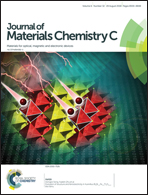Improving SERS hot spots for on-site pesticide detection by combining silver nanoparticles with nanowires†
Abstract
Surface-enhanced Raman scattering (SERS) is a rapid and effective method for identifying fingerprint structures at low concentrations. However, the application of SERS for on-site detection with flexible and robust structures is challenging. In this work, we have developed a flexible, robust and reusable silver-functionalized SERS substrate for pesticide residue detection. This SERS substrate is composed of a silver nanoparticle@nanowire (AgNP@AgNW) network that is embedded into polydimethylsiloxane. The unique network structure provides rich SERS “hot spots”, where the electromagnetic field can be magnified through the excitation of localized surface plasmon resonances of AgNPs that surround AgNWs. The embedded structure improves the adsorption ability of the surface for target molecules, thereby reducing Raman fluorescence. In addition, this substrate retains 54.7% of the original Raman intensity after ten cycles; hence, this substrate shows satisfactory recyclability performance. Moreover, the SERS substrate exhibits acceptable detection reproducibility with 4.22% relative standard deviation and satisfactory tensile properties. These results demonstrate that our substrate has the potential for use in environmental supervision, food safety, explosive detection and security applications.



 Please wait while we load your content...
Please wait while we load your content...